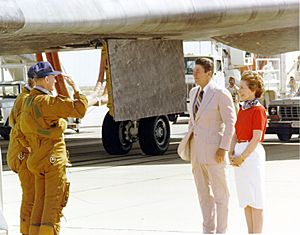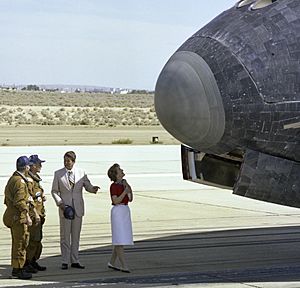Henry Hartsfield facts for kids
Quick facts for kids
Henry W. Hartsfield Jr.
|
|
|---|---|
 |
|
| Born | November 21, 1933 Birmingham, Alabama, U.S.
|
| Died | July 17, 2014 (aged 80) Houston, Texas, U.S.
|
| Nationality | American |
| Other names | Henry Warren Hartsfield Jr. |
| Alma mater | Auburn University, B.S. 1954 Duke University Air Force Institute of Technology University of Tennessee, M.S. 1971 |
| Occupation | Test pilot |
| Awards | |
| Space career | |
| USAF / NASA Astronaut | |
| Rank | |
|
Time in space
|
20d 02h 50m |
| Selection | 1966 USAF MOL Group 1969 NASA Group 7 |
| Missions | STS-4, STS-41-D, STS-61-A |
|
Mission insignia
|
|
| Retirement | March 1998 |
Henry Warren Hartsfield Jr. (born November 21, 1933 – died July 17, 2014) was a brave American astronaut and a Colonel in the United States Air Force. He spent over 480 hours flying in space! In 2006, he was honored by being added to the United States Astronaut Hall of Fame.
Henry Hartsfield was born in Birmingham, Alabama. He was married to Judy Frances Massey and they had a daughter named Judy Lynn.
Contents
Education and Early Career
Henry Hartsfield finished high school in Birmingham, Alabama. He then went to Auburn University and earned a degree in Physics in 1954. He also studied physics at Duke University. Later, he earned a master's degree in Engineering Science from the University of Tennessee in 1971.
Air Force Experience
Hartsfield joined the United States Air Force in 1955. He flew fighter jets in West Germany. He also became a test pilot and an instructor at the U.S. Air Force Test Pilot School in California.
In 1966, he joined the Air Force's Manned Orbiting Laboratory (MOL) program as an astronaut. When this program ended in 1969, he moved to NASA. He flew over 7,400 hours in many different types of jet aircraft.
NASA Astronaut Missions
Henry Hartsfield became a NASA astronaut in September 1969. He helped support the Apollo 16 mission. He also worked on the Skylab missions and was a CAPCOM (Capsule Communicator) for STS-1. A CAPCOM is the person on Earth who talks to the astronauts in space.
In 1977, Hartsfield retired from the Air Force but continued working for NASA as a civilian astronaut. He helped develop the Space Shuttle's flight control system.

STS-4: First Space Shuttle Flight
Hartsfield was the pilot for STS-4, the fourth and final test flight of the Space Shuttle Columbia. This mission launched from Kennedy Space Center, Florida, on June 27, 1982. He flew with Commander Thomas K. Mattingly II.
The seven-day mission helped NASA test the shuttle's launch and landing. The crew also studied how long-term heat and cold affected the shuttle. They ran scientific experiments, including one that separated biological materials. They even fixed an experiment in space, which was a first! STS-4 orbited the Earth 112 times before landing in California on July 4, 1982.

STS-41-D: Maiden Flight of Discovery
Hartsfield was the commander of STS-41-D, which launched on August 30, 1984. This was the very first flight of the Space Shuttle Discovery. His crew included Michael L. Coats, Judith A. Resnik, Steven A. Hawley, Richard M. Mullane, and Charles D. Walker.
During this six-day mission, the crew deployed three satellites. They also tested a new solar cell wing experiment. Hartsfield and his crew were called "Icebusters" because he successfully used the Canadarm to remove dangerous ice from the shuttle. STS-41-D completed 96 orbits before landing on September 5, 1984.
STS-61-A: Spacelab D-1 Mission
For his third flight, Hartsfield commanded STS-61-A on the Space Shuttle Challenger. This mission launched on October 30, 1985. It was a special mission because it was the first time eight crew members flew together. It was also the first Spacelab science mission planned and controlled by a foreign country (West Germany).
The crew included Steven R. Nagel, James F. Buchli, Guion S. Bluford Jr., Bonnie J. Dunbar, Reinhard Furrer, Ernst Messerschmid, and Wubbo Ockels. They completed over 75 scientific experiments in areas like biology and materials processing. After 111 orbits, STS-61-A landed on November 6, 1985. This was the last successful flight of Challenger before its tragic accident on its next mission.
After these three missions, Henry Hartsfield had spent a total of 483 hours in space.
Later Career and Honors
After his space flights, Hartsfield held important leadership roles at NASA. From 1986 to 1987, he was the Deputy Chief of the Astronaut Office. He later became the Deputy Director for Flight Crew Operations at the Johnson Space Center.
He also worked at NASA Headquarters in Washington, D.C., helping to integrate the International Space Station (ISS) requirements into the Space Shuttle systems. He also worked at the Marshall Space Flight Center on Space Station operations. In 1993, he became the Manager of ISS Independent Assessment, overseeing the program's safety.
Hartsfield retired from NASA in 1998. He then worked for Raytheon Company as a vice president before retiring in 2005.
Special Honors

Henry Hartsfield received many awards for his service and achievements:
- Air Force Meritorious Service Medal
- General Thomas D. White Space Trophy (1973)
- Inducted into the Alabama Aviation Hall of Fame (1983)
- Distinguished Civilian Service Award (DOD) (1982)
- NASA Distinguished Service Medals (1982, 1988)
- NASA Space Flight Medals (1982, 1984, 1985)
- NASA Exceptional Service Medal (1988)
- Honorary Doctor of Science degree from Auburn University (1986)
- Inducted into the U.S. Astronaut Hall of Fame (2006)

